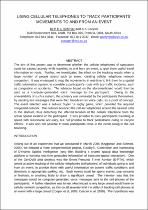JavaScript is disabled for your browser. Some features of this site may not work without it.
- ResearchSpace
- →
- Research Publications/Outputs
- →
- Conference Publications
- →
- View Item
| dc.contributor.author |
Schmitz, P

|
|
| dc.contributor.author |
Cooper, Antony K

|
|
| dc.date.accessioned | 2012-01-10T10:04:22Z | |
| dc.date.available | 2012-01-10T10:04:22Z | |
| dc.date.issued | 2011-07 | |
| dc.identifier.citation | Schmitz, PMU and Cooper, AK. 2011. Using cellular telephones to track participants' movements to and from an event. 30th Southern African Transport Conference (SATC 2011), Pretoria, South Africa, 11-14 July 2011 | en_US |
| dc.identifier.uri | http://hdl.handle.net/10204/5462 | |
| dc.description | 30th Southern African Transport Conference (SATC 2011), Pretoria, South Africa, 11-14 July 2011 | en_US |
| dc.description.abstract | The aim of this project was to determine whether the cellular telephones of spectators could be tracked actively while travelling to and from an event, to give them useful travel information en route. Further, the authors investigated the effect on the tracking results when a large number of people attend such an event, creating cellular telephone network congestion. It was envisaged to map the movements in real-time to link them to a spatial traffic information system, to correlate a participant‘s route with any traffic incidents, such as congestion or accidents. The advisory based on the aforementioned would then be sent as a computer-generated voice message to the participant. Owing to the unavailability of such a system, the advisory was simulated by the participants themselves, by sending text messages that were then broadcast as voice calls, as a proof of concept. The event selected was a sell-out Super 14 rugby game, which provided the required congested network. The network bounced the cellular telephones around the nearest cells to the stadium, thus detaching the inferred location of the cellular telephone from the actual spatial location of the participant. It was possible to track participants travelling at speed with reasonable accuracy, but not possible to track pedestrians owing to canyon effects. It was also not possible to track participants close to the event owing to the cell bouncing. | en_US |
| dc.language.iso | en | en_US |
| dc.publisher | SATC 2011 | en_US |
| dc.relation.ispartofseries | Workflow request;7764 | |
| dc.subject | Cellular networks | en_US |
| dc.subject | Cellular telephones | en_US |
| dc.subject | Transport planning | en_US |
| dc.subject | Cellular tracking | en_US |
| dc.subject | Transport | en_US |
| dc.subject | Transportation | en_US |
| dc.subject | SATC 2011 | en_US |
| dc.title | Using cellular telephones to track participants' movements to and from an event | en_US |
| dc.type | Conference Presentation | en_US |
| dc.identifier.apacitation | Schmitz, P., & Cooper, A. K. (2011). Using cellular telephones to track participants' movements to and from an event. SATC 2011. http://hdl.handle.net/10204/5462 | en_ZA |
| dc.identifier.chicagocitation | Schmitz, P, and Antony K Cooper. "Using cellular telephones to track participants' movements to and from an event." (2011): http://hdl.handle.net/10204/5462 | en_ZA |
| dc.identifier.vancouvercitation | Schmitz P, Cooper AK, Using cellular telephones to track participants' movements to and from an event; SATC 2011; 2011. http://hdl.handle.net/10204/5462 . | en_ZA |
| dc.identifier.ris | TY - Conference Presentation AU - Schmitz, P AU - Cooper, Antony K AB - The aim of this project was to determine whether the cellular telephones of spectators could be tracked actively while travelling to and from an event, to give them useful travel information en route. Further, the authors investigated the effect on the tracking results when a large number of people attend such an event, creating cellular telephone network congestion. It was envisaged to map the movements in real-time to link them to a spatial traffic information system, to correlate a participant‘s route with any traffic incidents, such as congestion or accidents. The advisory based on the aforementioned would then be sent as a computer-generated voice message to the participant. Owing to the unavailability of such a system, the advisory was simulated by the participants themselves, by sending text messages that were then broadcast as voice calls, as a proof of concept. The event selected was a sell-out Super 14 rugby game, which provided the required congested network. The network bounced the cellular telephones around the nearest cells to the stadium, thus detaching the inferred location of the cellular telephone from the actual spatial location of the participant. It was possible to track participants travelling at speed with reasonable accuracy, but not possible to track pedestrians owing to canyon effects. It was also not possible to track participants close to the event owing to the cell bouncing. DA - 2011-07 DB - ResearchSpace DP - CSIR KW - Cellular networks KW - Cellular telephones KW - Transport planning KW - Cellular tracking KW - Transport KW - Transportation KW - SATC 2011 LK - https://researchspace.csir.co.za PY - 2011 T1 - Using cellular telephones to track participants' movements to and from an event TI - Using cellular telephones to track participants' movements to and from an event UR - http://hdl.handle.net/10204/5462 ER - | en_ZA |






